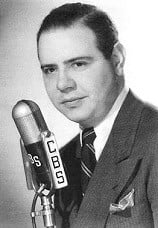
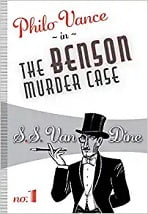 Philo Vance (1943-45, 1945, 1946-52) aired “The Merry Murder Case” several times, this broadcast being from July 20, 1948 as the second episode of the 1948 season. The number of total aired episodes is unknown due to the lack of information on the 1943-45 run, though a good estimate combining the other two runs comes close to 120. This is but the third episode of this exemplary show we have showcased, the other two being in August of 2019 and June of 2018. For newcomers and for those needing to refresh their memories from those first offerings, we reprise (with minor variation) the initial background information.
Philo Vance (1943-45, 1945, 1946-52) aired “The Merry Murder Case” several times, this broadcast being from July 20, 1948 as the second episode of the 1948 season. The number of total aired episodes is unknown due to the lack of information on the 1943-45 run, though a good estimate combining the other two runs comes close to 120. This is but the third episode of this exemplary show we have showcased, the other two being in August of 2019 and June of 2018. For newcomers and for those needing to refresh their memories from those first offerings, we reprise (with minor variation) the initial background information.
The character of detective Philo Vance was the brainchild of S. S. Van Dine (pseudonym of Willard Huntington Wright, 1887-1939). Wright would pen 12 Philo Vance novels between 1926 and 1939, the first of which was The Benson Murder Case (1926) and the last being The Winter Murder Case which he finished shortly before his death in April of 1939. Vance was very much in the mold of the “gentleman detective” or what would come to be known as the “soft-boiled” variety of detective. He has much in common with Sherlock Holmes and Nero Wolfe in that he was in possession of a giant intellect, though his arrogance and aloofness surpassed that of the former detectives and put many off. As Wright himself wrote of his character (via Van Dine) in The Benson Murder Case: “Vance was what many would call a dilettante, but the designation does him an injustice. He was a man of unusual culture and brilliance. An aristocrat by birth and instinct, he held himself severely aloof from the common world of men. In his manner there was an indefinable contempt for inferiority of all kinds. The great majority of those with whom he came in contact regarded him as a snob. Yet there was in his condescension and disdain no trace of spuriousness. His snobbishness was intellectual as well as social. He detested stupidity even more, I believe, than he did vulgarity or bad taste. I have heard him on several occasions quote Fouché’s famous line: C’est plus qu’un crime; c’est une faute. And he meant it literally.
“Vance was frankly a cynic, but he was rarely bitter; his was a flippant, Juvenalian cynicism. Perhaps he may best be described as a bored and supercilious, but highly conscious and penetrating, spectator of life. He was keenly interested in all human reactions; but it was the interest of the scientist, not the humanitarian.
“Vance’s knowledge of psychology was indeed uncanny. He was gifted with an instinctively accurate judgement of people, and his study and reading had coordinated and rationalized this gift to an amazing extent. He was well grounded in the academic principles of psychology, and all his courses at college had either centered about this subject or been subordinated to it…
“He had reconnoitered the whole field of cultural endeavor. He had courses in the history of religions, the Greek classics, biology, civics, and political economy, philosophy, anthropology, literature, theoretical, and experimental psychology, and ancient and modern languages. But it was, I think, his courses under Münsterberg and William James that interested him the most.”
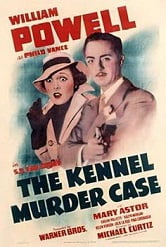 Unfortunately (or fortunately as is your preference), the radio and film portrayals of Vance toned down his aloof disdain for the common man and made him more likable for audiences. Speaking of the films, there were a dozen adapted from 1929 through 1940. There were a trio of later films made in 1947 but they had nothing to do with the novels and little relationship to the Vance character. Of the first five films (two in 1929, two in 1930–one being The Benson Murder Case, and the fifth in 1933) William Powell starred in four, while future Sherlock Holmes film star of the 1940s, Basil Rathbone, starred in the fourth (The Bishop Murder Case, 1930). The final Powell role as Vance came with 1933’s The Kennel Murder Case. Such was Powell’s popularity and connection with the movie-going audience that in 1934, barely a year later, he would co-star with Myrna Loy in the first of the classic films adapted from Dashiell Hammett’s The Thin Man detective novels and stories.
Unfortunately (or fortunately as is your preference), the radio and film portrayals of Vance toned down his aloof disdain for the common man and made him more likable for audiences. Speaking of the films, there were a dozen adapted from 1929 through 1940. There were a trio of later films made in 1947 but they had nothing to do with the novels and little relationship to the Vance character. Of the first five films (two in 1929, two in 1930–one being The Benson Murder Case, and the fifth in 1933) William Powell starred in four, while future Sherlock Holmes film star of the 1940s, Basil Rathbone, starred in the fourth (The Bishop Murder Case, 1930). The final Powell role as Vance came with 1933’s The Kennel Murder Case. Such was Powell’s popularity and connection with the movie-going audience that in 1934, barely a year later, he would co-star with Myrna Loy in the first of the classic films adapted from Dashiell Hammett’s The Thin Man detective novels and stories.
For the 1945 summer replacement series, native-born Puerto Rican actor (Tony {1947} and Oscar {1950} award winner, both for his portrayal of Cyrano de Bergerac) Jose Ferrer (1912-1992), would play Vance, and his portrayal is considered by critics and lovers of the series to be one of the best. For the much longer 1946-52 run, Jackson Beck (photo top right, 1912-2004) would play Vance, and many consider his performance to be the penultimate one, Ferrer notwithstanding. Beck is also known as the announcer for the much beloved The Adventures of Superman radio series (1940-51), and for the voice of Bluto in the series of short animated Popeye features begun in 1933 and shown in theaters across the country.
“The Merry Murder Case” is an unusual one, for while a literary speaker is this episode’s requisite murder victim we have three different people claiming to have shot him. When Vance learns there are three bullets in the corpse he must not only find which bullet actually killed the lecturing psychologist but then find the gun the bullet came from, then who owned the gun–and then finally the reason for the murder in the first place. An unusual series of mysteries to be sure, and a fitting intellectual exercise for Philo Vance as he attempts to expose the culprit in “The Merry Murder Case.”
Play Time: 26:34
{The hot summer months of 1948 found the neighborhood gang taking respite from the heat in the shady confines of their neighborhood newsstand, lingering over many a pulp magazine cover before deciding on their selections. Street & Smith’s Detective Story Magazine (1915-53) had been around seemingly forever and provided no shortage of quality detective fare. It was a monthly in 1948 but only through July when it would skip a month and end the year with a September issue for a total of 8 issues in 1948. It would see only 3 issues in all of 1949 and cease publication until 1952 when it produced only one issue. Its final 5 bi-monthly issues would appear in 1953. Dime Detective (1931-53), begun during the depression, provided rough and tumble mayhem of all sorts, and like many another crime or detective pulp, featured a woman in distress on its covers. It was a monthly in 1948. The Phantom Detective (1933-53) was always a favorite and was Standard Magazine’s answer to Street & Smith’s The Shadow magazine. While its publishing schedule was only about half as many issues a year as that of The Shadow, the fact that it lasted just over 20 years gives it the distinction of being the longest-running single hero pulp of all time. It was a bi-monthly in 1948. Note also that with this batch of detective pulps their runs ended in 1953, a bad year for all pulp genres.]
[Left: Detective Story, July 1948 – Center: Dime Detective, July 1948 – Right: The Phantom Detective, July 1948]
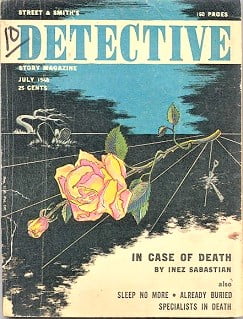
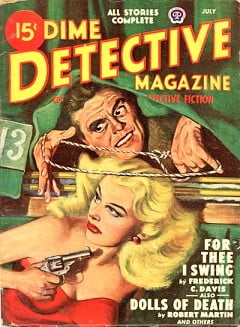
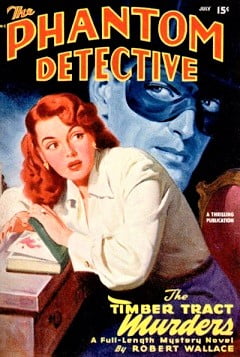
To view the entire list of Old Time Radio episodes go here.